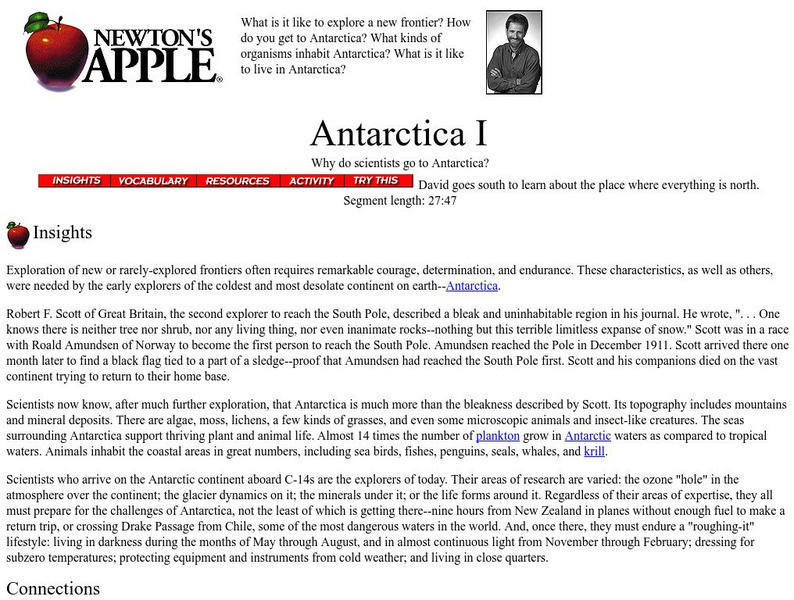Hi, what do you want to do?
Curated OER
Breaking News English: Map Shows Chinese Discovered America
For this English worksheet, students read "Map Shows Chinese Discovered America," and then respond to 47 fill in the blank, 7 short answer, 20 matching, and 8 true or false questions about the selection.
Curated OER
Breaking News English: Map Shows the Chinese Discovered America
In this English worksheet, students read "Map Shows the Chinese Discovered America," and then respond to 47 fill in the blank, 7 short answer, 20 matching, and 8 true or false questions about the selection.
Curated OER
Oceans
In this oceans worksheet, student use clues from a song titled "Oceans," then locate and label the 5 oceans. An answer key is given but page doesn't included a song link.
Curated OER
Animals Galore Quiz
In this online quiz worksheet, students answer a set of multiple choice questions about animal facts. Page includes links to answers, ads and resources.
Curated OER
Global Change — Change and Cycles Where Land, Air and Water Meet
Students participate in an experiment to define a parts-per-billion solution. For this ecology lesson, students select a second substance to create a parts-per-billion solution and observe and record their results. Students work in...
Curated OER
Writing Postcards
In this writing skills worksheet, students imagine they are visiting Antarctica and write a postcard home about their experiences. Students use the picture for help.
Illustrative Mathematics
Comparing Temperatures
Which is colder -12 or -18? Temperature is natural real-world application of ordering rational numbers. It's also fun to talk about the lowest recorded temperature on Earth. Take the time to discuss this inquiry with your class.
Polar Trec
Temperature Profile above the South Pole
Collecting and understanding data is a big part of understanding the world and how it changes. To better grasp what temperatures are changing and how they affect global populations, learners create a graph based on the date provided....
Teach Engineering
Backyard Weather Station
Challenge young meteorologists to apply their knowledge of weather to build their own weather stations. The resource provides the directions to build a weather station that contains a wind vane, barometer, thermometer, and rain...
Curated OER
Blubber Gloves
The ways that animals adapt to their environments is quite remarkable. In this life science lesson, fifth graders take a look at some of the ways that aquatic animals that live in Arctic or Antarctic waters survive. They perform an...
Smithsonian Institution
Watching Crystals Grow
Amazing science can sometimes happen right before your eyes! The class gets cozy as they watch crystals grow. They use Epsom salts, rocks, and food coloring to create crystals. They'll observe the entire process, documenting every step...
Society for Science and the Public
Science News for Students: Massive Ice Shelf Is Poised to Break Off of Antarctica
Uh oh! A fast-growing crack in Antarctica's Larsen C ice shelf could soon release a truly huge hunk of ice into the ocean.
Society for Science and the Public
Science News for Students: Antarctica Warms, Which Threatens Penguins
Describes the threat of climate change in the Antarctica to emperor penguins by affecting the ice sheets where penguin breeding grounds are located.
CommonLit
Common Lit: What Is Antarctica?
CommonLit.org is a wonderful resource to use in a Language Arts classroom. Each story or article is accompanied by guided reading questions, assessment questions, and discussion questions. In addition, students can click on words to see...
Other
Commonwealth of Antarctica: Classroom Antarctica
The focus of this site is Antarctica. Designed for fifth- through eighth-grade students, this site contains detailed lesson plans, learning activities, digital images, and links to related resources.
E-learning for Kids
E Learning for Kids: Science: Antarctica Research Center: Describe Different Weather Patterns
This module provides informational text about weather. Students will learn about precipitation and storm fronts. Students will also learn about different types of storms, including the following: hurricanes, cyclones, and typhoons.
E-learning for Kids
E Learning for Kids: Science: Antarctica/ What Are the Different Parts of the Universe?
In this lesson, students learn about objects in the universe, including constellations, planets, meteors, asteroids, and comets.
E-learning for Kids
E Learning for Kids: Antarctica: Penguins: What Are the Different Aspects of the Weather?
For this lesson, students learn about the different types of weather and the factors that impact them, including air pressure, humidity, sun and wind.
E-learning for Kids
E Learning for Kids: Science: Antarctica: Which Types of Sounds Do You Know?
For this lesson, students learn about the five senses, identify objects that make sound, and take a fun fact quiz at the end.
E-learning for Kids
E Learning for Kids: Science: Antarctica: When Were Cells First Discovered?
Students learn about the parts of a cell and how they were first discovered. Includes a fun fact quiz at the end.
E-learning for Kids
E Learning for Kids: Science: Antarctica Research Center: What Do Cells Do?
For this lesson, students learn about the specialization of cells to perform different functions, and how they are organized into tissues and organs in the human body.
E-learning for Kids
E Learning for Kids: Antarctica Fishing Boat: Where Do Sounds Come From?
In this lesson, students explore where sounds come from and the different sounds that animals make.
Penguin Science
Penguin Science: Penguins Marching Into the Classroom
Follow Adelie Penguin families as they raise their chicks. Daily pictures (November through January) from the penguin colony on Ross Island, Antarctica. are posted with data for students to keep a field journal. Inquiry classroom...
Michigan Reach Out
Twin Cities Public Television: Antarctica I
After learning why scientists go to Antarctica, students plan and go on an expedition of an "unexplored" territory themselves. Planning guide for the expedition is included.




























